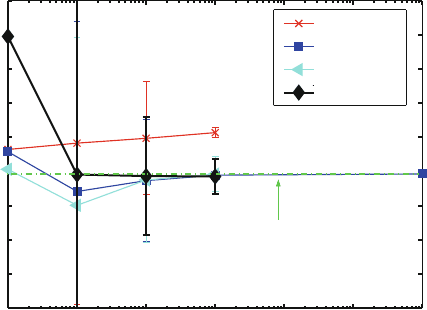Schlick T. Molecular Modeling and Simulation: An Interdisciplinary Guide
Подождите немного. Документ загружается.


400 12. Monte Carlo Techniques
12.2.5 Artifacts
Two interesting examples that illustrate the importance of quality random num-
ber generators and their appropriate testing with the application at hand are
summarized in Boxes 12.3 and 12.4.
The first, from a real situation in 1989, reflects a coincidental relationship
between the problem (matrix) size and the period of the generator (the ma-
trix dimension divides the period τ), as well as short τ and limited accuracy
(single-precision computer arithmetic). These problems could have been avoided
by averting this matrix-dimension/generator-period relationship, increasing the
generator period, and using double-precision arithmetic.
The second instructive example of “hidden errors” stemming from apparently
good random number generators was reported in 1992 [392]. Essentially, the
researchers showed that incorrect results can be produced under certain circum-
stances by random number generators that have a long period and have passed
certain tests for randomness. Thus, a careful testing of the combination of ran-
dom number generator and application is generally warranted. Though thought
to be generators of high-quality, the generators used in [392] are known to have
unfavorable lattice structure [714]. Of course, these examples also argue for using
generators with as-long-a-period as possible.
In addition to possible systematic errors with high-quality random number gen-
erators for some algorithms due to subtle correlations, researchers showed that
even good generators can yield inconsistent results regardless of the algorithm
[1046]. Though researchers believed that the two used generators had passed all
known statistical tests, the generators produced (with the same algorithm) critical
temperature estimates for the continuous clock model that differed by 2%, much
higher than intrinsic errors. This model has a second-order phase transition, and
the exact answer is not known. Thus, it cannot be determined which result is more
reliable.
The best advice, therefore, appears to be not only to use reliable generators
with as long periods as possible, but also to experiment with several generators
as well as algorithms to the extent possible.
Box 12.3: Accidental Relationship Between Problem Size and Generator Length
(1989 Linpack Benchmarks)
In 1989, David Hough, a numerical analyst working at Sun Microsystems, noticed very
peculiar behavior in benchmark testing of the package Linpack. (The original posting can
be found on the archived NA Digest, Volume 89, Issue 1, 1989). The single-precision
factorization of 512 × 512 randomly-generated matrices produced a perplexing underflow
(roughly around 10
−40
) in the diagonal pivot values. (Sherlocks: note that 512 = 2
9
).
However, matrices composed of random data from a uniform distribution are known to
be remarkably well conditioned! So how can this seemingly well conditioned matrix be
nearly singular?

12.2. Random Number Generators 401
The answer came upon examination of the random number generator and how it was
used to set the matrix elements. Specifically, the matrix elements a
ij
weresettobeinthe
range [−2, 2] according to the following subprogram, which relies on a simple MLCG with
a = 3125 and M = 65536.(Holmes fans: note that M =2
16
).
c
******************************************************************
subroutine matgen(amat,Lda,n,b,norma)
real amat(Lda,1), b(1), norma, halfm, quartm
integer a, m
parameter (a = 3125, m = 65536)
parameter (halfm = 32768.0, quartm = 16384.0)
iseed = 1325
norma = 0.0
do 30 j = 1, n
do 20 i = 1, n
iseed = mod (a
*
iseed, m)
amat(i,j) = (iseed - halfm) / quartm
norma = max (amat(i,j), norma)
20 continue
30 continue
return
end
c
******************************************************************
A quick examination first showed that the period of this MLCG is only τ = M/4=
16384; the full period of M could have easily been generated by changing one line above,
to incorporate the nonzero c = −1 increment value. Still, this would have only delayed
the underflow problem to a 1024 × 1024 matrix.
The main problem here lies in the fact that the matrix size chosen, 512 = 2
9
, divides the
modulus, also a power of 2 (M =2
16
). Hence, the period τ =2
14
factors τ = 512 ×32.
This means that the first 32 columns of the “random” matrix are repeated 16 times! The
matrix is subsequently singular, and after each 32 steps of Gaussian elimination the zeros
in the lower triangular part of the matrix are reduced by a factor of order (10
−7
). Clearly,
after six rounds of such transformations (each treating 32 columns), the element size in
the lower triangle would drop to order O(10
−42
), explaining the underflow. This problem
could have been removed by using matrix sizes that do not divide the period, resorting to
double precision arithmetic (underflow threshold of 10
−300
), and by increasing the period
of the generator substantially.
Note also that besides underflow, the generator could have experienced other problems
for matrices smaller than 512 ×512,since512 × 512 = 2
18
,and2
18
is greater than 2
14
,
the generator’s period.
12.2.6 Recommendations
In sum, high-quality, long-sequence random number generators are easy to
find in the literature, but they are not necessarily available on default system
implementations.

402 12. Monte Carlo Techniques
For the best results, an MC simulator is well advised to consult the resident
mathematical expert for the most suitable generator and computing platforms
with respect to the application at hand.
Certainly, the user should compare application results as obtained for several
random number generators. Indeed, L’Ecuyer likens generators to cars [716]: no
single model nor size of an automobile can possibly be a universal choice. Good
expert advice can be obtained by examining Pierre L’Ecuyer’s website (presently
at www.iro.umontreal.ca/∼lecuyer). Certainly, given today’s computationally-
intensive biomolecular simulations, it is advisable to use sequences with long
periods. Combined multiplicative linear congruential generators are good choices.
See [716] for good recommendations. See also [607, pp. 76–78] for an efficient
FORTRAN implementation of a good combination MLCG used for DNA work,
though with a small period by today’s standards (10
18
).
Generators particularly suitable for parallel machines are also available [559,
985], characterized by different streams of variates produced by good seeding
algorithms and variations in the parameters of the underlying recursion for-
mulas. See the SPRNG scalable library package (Scalable Parallel Random
Number Generation) targeted for large-scale parallel Monte Carlo applications:
sprng.cs.fsu.edu, for software. The package can be used in C, C++, and Fortran
and has been ported to most major computer platforms.
Box 12.4: Accidental Relationship Between Simulation Protocol and Generator
Structure (Ising Model)
Ferrenberg et al. [392] used different generators in the context of simulating an Ising
model, a model characterized by an abrupt, temperature-dependent transition from an
ordered to a disordered state. The states, characterized by the spin directionality of the
particles, were generated by an algorithm termed Wolff that determines the flips of a
cluster on the basis of a random number generator. Surprisingly, the researchers found
that the correct answer was approximated far better by the 32-bit multiplicative linear
congruential generator SURAND, well recognized to have lattice-structure defects. So
why does the apparently-superior shift register generator produce systematically incorrect
results — energies that are too low and specific heats that are too high?
An explanation to these observations came upon inspection of the Wolff algorithm.
Namely, subtle correlations in the random number sequence affect the Wolff algorithm in
a specific manner! If the high order bits are zero, they will remain zero according to the
spin generation algorithm. This in turn leads to a bias in the cluster size generated and
hence the type of equilibrium structures generated.
The main message from this work was a note of caution on the effect of subtle cor-
relations within random number generators on the system generation algorithms used for
simulating the physical system. This suggests that not only should a generator be tested
on its own; it should be tested together with the algorithm used in the MC simulation to
reduce the possibility of artifacts.
12.3. Gaussian Random Variates 403
12.3 Gaussian Random Variates
12.3.1 Manipulation of Uniform Random Variables
Our uniform random variates computed in the last section, U , can be used to gen-
erate variates X that correspond to a more general, given probability distribution
by a simple transformation. To generate a continuous variate X with distribution
function F (x) (see Box 12.1) which is continuous and strictly increasing on (0, 1)
(i.e., 0 <F(x) < 1), we set x to F
−1
(u) where F
−1
is the inverse of the func-
tion F . The challenge in practice is to establish good algorithms for evaluating
F
−1
(u) to the desired accuracy.
Below we only describe generating variates from a Gaussian (normal) distribu-
tion, commonly needed in molecular simulations. For information on generating
variates from many other distributions, see [706] and the web page of Luc
Devroye, for example.
12.3.2 Normal Variates in Molecular Simulations
A vector of normally-distributed random variates satisfying a given mean (μ)and
variance (σ
2
)(seeBox12.1,eq.(12.5)) is often required in molecular simulations.
One example is the initial velocity vector (of components {v
i
}) in a molecu-
lar dynamics simulation corresponding to the target temperature of an n-atom
system,
3n
i=1
m
i
v
2
i
=3nk
B
T .
Another example is the Gaussian random force vector R in Langevin dynamics
with zero mean and variance chosen so as to satisfy:
R(t)R(t
) =2γk
B
TMδ(t − t
) , (12.22)
where M is the mass matrix and γ is the damping constant.
In the molecular and Langevin dynamics cases above, we first set each compo-
nent of the vector vec from a standard normal distribution (zero mean and unit
variance) so that the sum is also a normal distribution with the additive means and
variances (see Central Limit Theorem below); to obtain the desired variance σ
2
rather than unit variance, we then modify each component according to the vector
update relation
vec ← σ vec + μ.
Since, by this modification, it is easy to generate normal variates from the normal
distribution with mean μ and variance σ
2
(N(μ, σ
2
)) from variates sampled from
a standard normal distribution (N(0, 1)), it suffices to generate standard normal
variates.
There are several techniques to set a variate X
u
from a Gaussian or normal dis-
tribution on the basis of a uniformly distributed variate U (for which procedures
were discussed above). Two are described below.

404 12. Monte Carlo Techniques
12.3.3 Odeh/Evans Method
One efficient approach was described by Odeh and Evans [928]. For a given u
value in the range 0 <u<1, the corresponding normal variable x
u
is computed
to satisfy:
u =
1
√
2π
x
u
−∞
exp(−t
2
/2) dt . (12.23)
This is accomplished by approximating x
u
as the sum of two terms:
x
u
= y + S(y)/T (y) ,y=
{ln(1/u
2
)},
where S and T are polynomials of degree 4 chosen to yield the minimal degree
rational approximation to x
u
− y with maximum error less than 10
−7
.
In practice, a vector of random variates is first formed (U ≡{u
1
,u
2
, ···,u
n
}
in the notation above; see subroutine ranuv below, based on function ranu), from
which a standard normal distribution is formulated (X
U
≡{x
u
1
,x
u
2
, ···,x
u
n
});
each component is then adjusted to yield the desired mean and standard deviation
(see subroutine rannv1 below).
c
******************************************************************
subroutine rannv1 (n, vec, mean, var)
c A vector of n pseudorandom numbers is generated, each from a
c standard normal distribution (mean zero, var. one), based on Odeh
c & Evans, App. Stat. 23:96 (1974). For a nonzero mean MU c and/or
c non unity variance, set vec(i) = mu + sqrt(sigma(i))
*
vec(i).
c Routine ranset should be called before the first subroutine call.
integer n
double precision vec(n),mean,var(n),
*
temp,p0,p1,p2,p3,p4,q0,q1,q2,q3,q4
parameter (p0=-.322232431088d0, p1=-1d0, p2=-.342242088547d0,
*
p3=-.204231210245d-1, p4=-.453642210148d-4,
*
q0=.99348462606d-1, q1=.588581570495d0, q2=.531103462366d0,
*
q3=.10353775285d0, q4=.38560700634d-2)
if (n .lt. 1) return
call ranuv(n, vec)
do 10 i = 1, n
temp = vec(i)
if (temp .gt. 0.5d0) vec(i) = 1d0 - vec(i)
vec(i) = sqrt(log(1d0/vec(i)
**
2))
vec(i) = vec(i) +
*
((((vec(i)
*
p4+p3)
*
vec(i) + p2)
*
*
vec(i) + p1)
*
vec(i) + p0) /
*
((((vec(i)
*
q4+q3)
*
vec(i) + q2)
*
*
vec(i) + q1)
*
vec(i) + q0)
if (temp .lt. 0.5d0) vec(i) = -vec(i)
10 continue
do 20 i = 1, n
vec(i) = sqrt(var(i))
*
vec(i) + mean
20 continue
return
end

12.3. Gaussian Random Variates 405
c
******************************************************************
subroutine ranuv (n, vec)
c Generate a vector of n pseudorandom uniform variates
integer n, a, m, q, r, seed
double precision vec(n), rm
parameter (a=16807, m=2147483647, q=127773, r=2836, rm=1d0/m)
common /random/ seed
save /random/
if (n .lt. 1) return
do 10 i = 1, n
seed = a
*
mod(seed, q) - r
*
(seed/q)
if (seed .le. 0) seed = seed + m
vec(i) = seed
*
rm
10 continue
return
end
c
******************************************************************
For example, to set the initial velocity vector according to the target temperature
using the equipartition theorem (each degree of freedom has k
B
T/2 energy at
thermal equilibrium), the routines above are used for the velocity vector V of 3n
components {v
i
} with μ =0and var(i) = (k
B
T)/m
i
. For the Langevin random
force vector, the variance for each vector coordinate i is: (2γk
B
m
i
T)/Δt,where
the delta function δ in eq. (12.22) is discretized on the basis of the timestep Δt
(see also Chapter 13 on molecular dynamics).
12.3.4 Box/Muller/Marsaglia Method
Another popular algorithm to form normal variates x
1
and x
2
is the Box/
Muller/Marsaglia method [663, pp. 117–118]. It involves generating two uni-
formly distributed random variates u
1
and u
2
, setting v
1
and v
2
as uniform variates
between −1 and +1 (v
1
← 2u
1
−1,v
2
← 2u
2
−1), checking that s = v
2
1
+ v
2
2
is
less than 1 (if s ≥ 1, the procedure is repeated), and then setting the two normal
variates x
1
and x
2
as:
x
1
= v
1
−2lns/s , x
2
= v
2
−2lns/s . (12.24)
Essentially, we are using the polar-coordinate representation of x
1
and x
2
by
v
1
and v
2
(x
1
=˜r cos
˜
θ,x
2
=˜r sin
˜
θ,˜r =
√
−2lns,
˜
θ =tan
−1
(v
2
/v
1
))to
construct the joint probability distribution of the two normal variates in polar
coordinates:
1
√
2π
x
1
−∞
e
−x
2
/2
dx
1
√
2π
x
2
−∞
e
−y
2
/2
dy
=
1
2π
{ (r, θ) |
r cos θ ≤ x
1
r sin θ ≤ x
2
}
e
−r
2
/2
rdrdθ. (12.25)

406 12. Monte Carlo Techniques
12.4 Means for Monte Carlo Sampling
12.4.1 Expected Values
Armed with a uniform random variate generator, we can now address the im-
portant task of estimating a mean property of interest. In molecular simulations,
we might seek the average geometric and energetic properties associated with an
equilibrium distribution of conformations.
MC Estimate
In its simplest form, we write such a mean, or expected value, as an integral
I =
D
A(x) dx = A(x)
D
(12.26)
where the average is computed over the uniformly distributed elements x ∈D.
For example, assume that the function A(x) is defined on [0, 1]. Choose a
sequence of N random variates for large N,
x
1
,x
2
,...,x
N
,
and generate corresponding function values y
i
= A(x
i
):
y
1
,y
2
,...,y
N
.
Then we compute the average, termed the Monte Carlo estimate of I, by:
¯y
N
=
1
N
N
i=1
y
i
. (12.27)
Simple Example: Calculate π by MC
As a simple example, consider calculating π by Monte-Carlo integration of the
area of a quarter-circle of radius 1 circumscribed inside the unit square in the
plane (with center at the origin of the plane). The integral to be evaluated is:
1
0
1
0
ρ(x, y) dx dy
where
ρ(x, y)=
1 x
2
+ y
2
≤ 1
0 else
.
This integral’s value is π/4. A simple Fortran program to perform this integration
by Monte Carlo sampling consists of the following:
c
*****************************************************************
subroutine monte(nstep)
implicit none
integer nstep, i, nin, iseed
double precision x, y, tmp, rand

12.4. Means for Monte Carlo Sampling 407
nin = 0
iseed = 12345
call srand(iseed)
do 30 i = 1, nstep
*
x = rand() /|\
y = rand() | ˆ
tmp = sqrt(x
*
x+y
*
y) | ˆ
if (tmp .lt. 1.d0) then |
nin = nin + 1 | ˆ
endif | \
30 continue +-----------
*
print
*
, nstep, (4.d0
*
nin)/nstep /
return
end
c
*****************************************************************
Results as a function of the sample size (nstep) are presented in Table 12.1 and
Figure 12.3 using the Unix rand and drand48 random number generators and
also more sophisticated methods. Since drand48 is the fastest of the generators,
we also record the estimated value corresponding to 10
12
steps (only up to 10
9
steps for the rest).
Note that, unfortunately, this procedure for calculating π is not very accurate.
At best, the first six decimal places of π =3.14159265358979323846 ... are
obtained. The accuracy is limited not only by the sample size — statistical error —
but also by any possible defects of the random number generator (e.g., lattice
structure and limited coverage; see Figure 12.2). Here we see that the accuracy
of the means starts to deteriorate after the number of steps exceeds the period
length. We also learn from this example that the longer-period generators have
greater resolution (another order of magnitude of two).
10
6
10
7
10
8
10
9
10
10
10
11
10
12
3.1412
3.1413
3.1414
3.1415
3.1416
3.1417
3.1418
3.1419
3.142
3.1421
π
Steps
π = 3.141592653589793
rand
drand48
clcg4
lfg
Figure 12.3. Results (means and error bars) of MC estimates for π based on different
random number generators, as tabulated in Table 12.1.

408 12. Monte Carlo Techniques
Table 12.1. Results of computing π by MC integration with various random number gen-
erators and sample sizes by the procedure described in the text, subroutine monte (on an
SGI R12K/300 MHz Octane processor). The value σ is computed from 100 runs for each
NSTEP value, except for 10
12
, for which it is based on one run. rand has τ ≈ 2
31
; 10
9
calls require 771 seconds (13 min.). drand48 has τ ≈ 2
48
; 10
9
calls require 656 seconds
(11 min.). clg4 has τ ≈ 2
31
; 10
9
calls require 5205 seconds (87 min.). lfg has τ ≈ 2
64
;
10
9
calls require 2106 seconds (35 min.). See also Figure 12.3.
Nstep Estimate Error σ,s.d.
rand, IRIX 6.5 system library
10
2
3.1604000000000E+00 1.8807346410208E−02 1.59E−01
10
3
3.1346800000000E+00 −6.9126535897936E−03 4.75E−02
10
4
3.1383680000000E+00 −3.2246535897933E−03 1.79E−02
10
5
3.1416736000000E+00 8.0946410208504E−05 5.22E−03
10
6
3.1416646400000E+00 7.1986410206115E−05 1.61E−03
10
7
3.1416831800000E+00 9.0526410207570E−05 4.74E−04
10
8
3.1416971676000E+00 1.0451401020672E−04 1.65E−04
10
9
3.1417139545200E+00 1.2130093020657E−04 1.37E−05
drand48, IRIX 6.5 system library
10
2
3.1408000000000E+00 −7.9265358979264E−04 1.72E−01
10
3
3.1456400000000E+00 4.0473464102098E−03 5.62E−02
10
4
3.1431880000000E+00 1.5953464102063E−03 1.53E−02
10
5
3.1418572000000E+00 2.6454641020690E−04 5.92E−03
10
6
3.1416580000000E+00 6.5346410206946E−05 1.61E−03
10
7
3.1415415040000E+00 −5.1149589793908E−05 4.97E−04
10
8
3.1415733104000E+00 −1.9343189793464E−05 1.79E−04
10
9
3.1415892614400E+00 −3.3921497935019E−06 4.70E−05
10
12
3.1415928451280E+00 1.9153820707274E−07 1.00E−06
clg4, based on four linear congruential generators [720]
10
2
3.1600000000000E+00 1.8407346410206E−02 1.51E−01
10
3
3.1413200000000E+00 −2.7265358979189E−04 4.98E−02
10
4
3.1405440000000E+00 −1.0486535897933E−03 1.74E−02
10
5
3.1416476000000E+00 5.4946410205758E−05 4.94E−03
10
6
3.1416064800000E+00 1.3826410206530E−05 1.59E−03
10
7
3.1415008760000E+00 −9.1777589792841E−05 4.92E−04
10
8
3.1415751016000E+00 −1.7551989793141E−05 1.82E−04
10
9
3.1415925054000E+00 −1.4818979332532E−07 5.05E−05
lfg, SPRNG package, modified lagged-Fibonacci generator
10
2
3.1372000000000E+00 −4.3926535897922E−03 1.70E−01
10
3
3.1414400000000E+00 −1.5265358979244E−04 5.20E−02
10
4
3.1442160000000E+00 2.6233464102083E−03 1.55E−02
10
5
3.1431008000000E+00 1.5081464102074E−03 5.23E−03
10
6
3.1419958000000E+00 4.0314641020611E−04 1.64E−03
10
7
3.1415909920000E+00 −1.6615897910910E−06 5.46E−04
10
8
3.1415866680000E+00 −5.9855897953653E−06 1.72E−04
10
9
3.1415854581200E+00 −7.1954697937748E−06 5.03E−05

12.4. Means for Monte Carlo Sampling 409
12.4.2 Error Bars
Law of Large Numbers
According to the Law of Large Numbers in probability theory, the average of N
sampled random variables converges (in probability) to its expected value. Stated
more formally, if the uniform variates are independent and drawn from the same
distribution so that the expected value of each y
i
is μ,thenasN →∞the average
value ¯y
N
converges to μ asymptotically:
P { lim
N→∞
(¯y
N
)=μ} =1.
However, the rate of convergence to the expected value is a different matter and
requires stronger assumptions.
Variance
As stressed in this chapter’s introduction, it is essential to provide error bars when
reporting an MC average. The variance of ¯y
N
is defined as
σ
2
¯y
=var(¯y)=
1
N
N
i=1
(y
i
− ¯y
N
)
2
. (12.28)
The variance measures the distribution of ¯y about its mean μ;thelargerN is, the
narrower the interval about I where ¯y
N
can be found.
Variance Relation to Central Limit Theorem
This interval can be determined as a probability of deviation in units of σ on the
basis of the Central Limit Theorem. This beautiful and powerful result states that
as N →∞,thelimiting distribution for a sum of random variates is the normal
distribution.
Specifically, if {y
1
,y
2
,...}is a sequence of independent, identically distributed
random variates having mean μ and finite nonzero variance σ
2
, then the random
variable
S
N
= y
1
+ y
2
+ ···+ y
N
has the normal density with mean Nμ and variance Nσ
2
, N(Nμ,Nσ
2
).Inother
words, the normalized random variable
S
N
− Nμ
var(S
N
)
=
S
N
− Nμ
σ
√
N
has the standard normal distribution:
lim
N→∞
P
S
N
− Nμ
σ
√
N
≤ x
=
1
√
2π
x
−∞
exp [−t
2
/2] dt .
